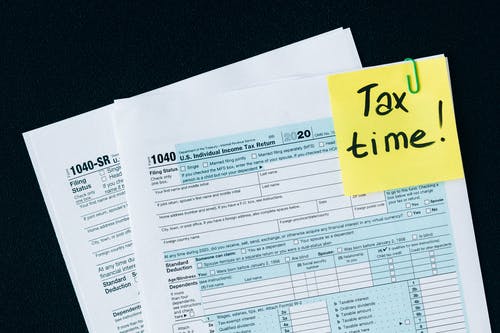Putting aside money from all your freelancer payments would help you pay quarterly taxes.
If you are a new freelancer, congratulations. You just stepped into the world of being self-employed or your own boss. If you worked a full-time job before, now, a lot of the responsibilities that used to fall on your employer’s hands are on yours. That includes handling federal income tax, Social Security, and Medicare or self-employment taxes. Regardless, don’t stress out. Here are 5 amazing tips to help make your first year of filing 1099 taxes. But first, let’s break down what a 1099 form is.
What is a 1099 Form?
A 1099 form is simply an information return. It’s a record that a client or business other than your employer gave or paid you money. Businesses are required to send a 1099 form to a freelancer or payee who has received at least $600 or more in payments during the tax year. Here’s a breakdown of some of the most common 1099 forms.
- Form 1099-NEC. This is the most common form freelancers typically receive. This is used to report non-employee compensation and the requirement to get a form is if you are paid $600 or more from a client.
- Form 1099-K. This form is for Payment Card and Third-Party Network Transactions. It’s a 1099 version that is used to report settlement of 3rd party payment network transactions and payments received through reportable payment card transactions.
- Form 1099-S. The S-forms are issued for money earned from real estate transactions.
- Form 1099-G. This form stands for “government payments” and is used to report payments collected by the freelancer from federal/state/local governments (e.g. local tax refunds and unemployment benefits).
- Form 1099-DIV. This form is sent to investors by financial institutions to report earnings from dividends.
- Form 1099-MISC. This form used to serve the purpose of form 1099-NEC, but, since 2020, it is issued for “miscellaneous income” that didn’t find a home in any of the other 1099 forms. Prize/award money, royalties, rent payments, attorney fees for the business, and other hard-to-categorize deductions belong on this form.
Now that you have an introduction to what 1099 forms are, it’s time to get into our tax tips.
- Figure Out How Much You’ll Owe Early
It is recommended that you should estimate your earnings as well as how much you’ll owe Uncle Sam at the end of the year. This is vital for you to prepare to pay your taxes on the income you earned from freelancing. The self-employment tax rate is 15.3%. It is composed of two parts. It’s the sum of 12.4% for Social Security and 2.9% for Medicare.
We recommend you use a free 1099 tax calculator to estimate your tax bill so you’ll know how much you’ll need to save in order to pay it off.

If you are an employee, it is fairly simple to calculate your tax liability as your income is pretty steady. As a freelancer, it’s a little tougher. A tax calculator will typically ask you to enter your gross earnings, how often you are paid, your filing status, and other information. A calculator is a good tool to inform you about your tax liability for each paycheck.
If you earned more than $400 in net earnings from freelancing, you are considered self-employed by the IRS and you’ll need to pay 1099 taxes. If you made less than $400 freelancing, you don’t need to pay self-employment taxes, however, you need to pay income tax on your earnings.
- Keep Track of All Your Receipts
Knowing how much you’ll owe at the end of the year may frighten you. After all, 15.3% of your income could be a fairly large sum of money depending on how much money you earn. Regardless, you need to keep track of all your business receipts in order to reduce that tax liability. You see, business expenses could be used to lower your tax bill as they are deducted from your taxable income.
Here’s a list of common deductions available to freelancers.
- Home office deduction
- Gas
- Work-related educational expenses
- GoodWill donations
- Business-specific cell phone use
- Office supplies or work equipment
- Expenses to hire professional contractors
- Car maintenance
- Insurance/ registration
- Business meals
- Travel
- Interest
Nowadays, there are many tax software available to help you automatically track 1099 expenses.
- Set Aside Money from Your Earnings
Every time you are paid, you should set money aside from your earnings to pay for your taxes. To cover your federal taxes, it is recommended by most accountants to set aside at least 30% of each payment you receive. Of course, this varies from business to business so determine your specific tax rate from your estimated earnings and save money accordingly. A good rule of thumb to be safe is to save 30-40% of your earnings.
When you receive money from a client, store at least 30% in a designated business bank account. By doing this, you’ll have the peace of mind when tax season rolls around.
Putting aside money from all your freelancer payments would help you pay quarterly taxes.
- Pay Quarterly Taxes
Freelancers or independent contractors who expect to owe $1,000 or more in taxes must pay estimated taxes quarterly. If you are an employee, your income would be withheld from your wages to pay for taxes. Since freelance income is not withheld by employers throughout the year and the U.S. operates on a “pay-as-you-go” system, you must pay estimated taxes on your income throughout the calendar year. This was put into place so freelancers would not have to worry about one large tax bill at the end of the year. Instead, they will pay them throughout the calendar year.
The due dates for quarterly taxes are as follows:
- April 15
- June 15
- September 15
- January 15 of the following year
You can make payments directly to the IRS here. Be sure to pay the correct amount because if you less than you owe, you’ll receive an underpayment penalty.
- Work with a Tax Professional if You Have Any Questions
It is always advised to consult with a tax professional at the end of the year to discover tax credits and deductions you qualify for and to make sure you properly file your taxes. If you have any questions about deductions or filing, a tax professional can give you the best answer.
Many times, freelancer accounts are not too complex and can be easily taken care of by tax software. Accountants just have the experience to streamline the work and make your life a lot easier if you can afford their services. Working with an accountant could save you a lot of time, money, and hassle down the line if you improperly file your taxes and you get audited.


Join the conversation!